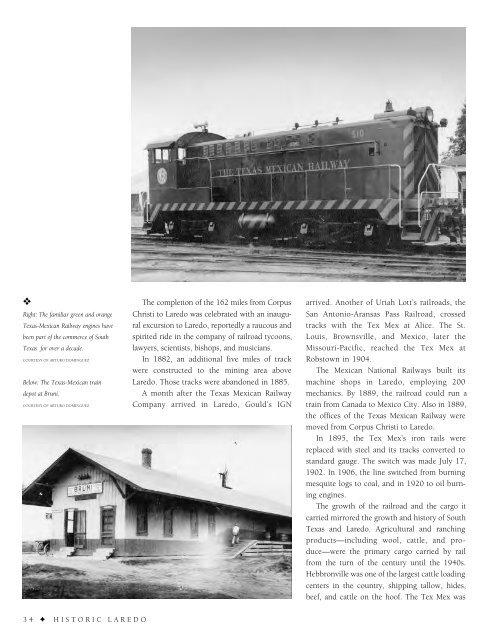Historic Laredo
An illustrated history of the city of Laredo and the Webb County area, paired with the histories of companies, families and organizations that make the region great.
An illustrated history of the city of Laredo and the Webb County area, paired with the histories of companies, families and organizations that make the region great.
You also want an ePaper? Increase the reach of your titles
YUMPU automatically turns print PDFs into web optimized ePapers that Google loves.
❖<br />
Right: The familiar green and orange<br />
Texas-Mexican Railway engines have<br />
been part of the commerce of South<br />
Texas for over a decade.<br />
COURTESY OF ARTURO DOMINGUEZ<br />
Below: The Texas-Mexican train<br />
depot at Bruni.<br />
COURTESY OF ARTURO DOMINGUEZ<br />
The completion of the 162 miles from Corpus<br />
Christi to <strong>Laredo</strong> was celebrated with an inaugural<br />
excursion to <strong>Laredo</strong>, reportedly a raucous and<br />
spirited ride in the company of railroad tycoons,<br />
lawyers, scientists, bishops, and musicians.<br />
In 1882, an additional five miles of track<br />
were constructed to the mining area above<br />
<strong>Laredo</strong>. Those tracks were abandoned in 1885.<br />
A month after the Texas Mexican Railway<br />
Company arrived in <strong>Laredo</strong>, Gould’s IGN<br />
arrived. Another of Uriah Lott’s railroads, the<br />
San Antonio-Aransas Pass Railroad, crossed<br />
tracks with the Tex Mex at Alice. The St.<br />
Louis, Brownsville, and Mexico, later the<br />
Missouri-Pacific, reached the Tex Mex at<br />
Robstown in 1904.<br />
The Mexican National Railways built its<br />
machine shops in <strong>Laredo</strong>, employing 200<br />
mechanics. By 1889, the railroad could run a<br />
train from Canada to Mexico City. Also in 1889,<br />
the offices of the Texas Mexican Railway were<br />
moved from Corpus Christi to <strong>Laredo</strong>.<br />
In 1895, the Tex Mex’s iron rails were<br />
replaced with steel and its tracks converted to<br />
standard gauge. The switch was made July 17,<br />
1902. In 1906, the line switched from burning<br />
mesquite logs to coal, and in 1920 to oil burning<br />
engines.<br />
The growth of the railroad and the cargo it<br />
carried mirrored the growth and history of South<br />
Texas and <strong>Laredo</strong>. Agricultural and ranching<br />
products—including wool, cattle, and produce—were<br />
the primary cargo carried by rail<br />
from the turn of the century until the 1940s.<br />
Hebbronville was one of the largest cattle loading<br />
centers in the country, shipping tallow, hides,<br />
beef, and cattle on the hoof. The Tex Mex was<br />
34 ✦ HISTORIC LAREDO
















